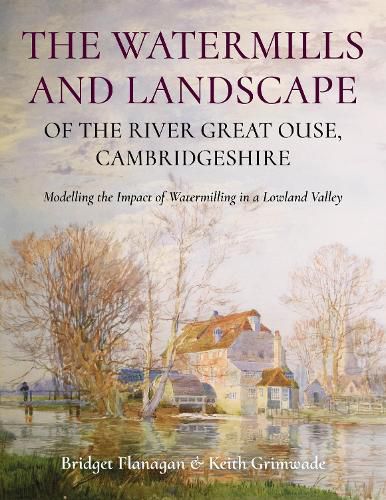Readings Newsletter
Become a Readings Member to make your shopping experience even easier.
Sign in or sign up for free!
You’re not far away from qualifying for FREE standard shipping within Australia
You’ve qualified for FREE standard shipping within Australia
The cart is loading…






The River Great Ouse in Cambridgeshire has a long history of water milling, stretching back to at least the 10th century and possibly to the Roman period. The authors use remote sensing (LiDAR), cartographic analysis, fieldwork, documents (especially contemporary litigation) and literary sources, to reveal new findings about this fascinating landscape. The Great Ouse's watermills were recorded as the most valuable in England in the Domesday Survey. All their sites are located, several having been long-lost, and a comprehensive explanation for their national pre-eminence is given. The expansion of activity in the Middle Ages is investigated through a detailed study of the disputes arising from the competing uses of the river and its flood plain for water milling, navigation and farming. Channel features that, hitherto, have either been ignored or attributed to natural processes are shown to be the result of milling activity. The continuing impact of water milling on the landscape until its decline in the second half of the 19th century is analyzed. The authors' findings have broader implications for the understanding of the development of water milling in lowland river landscapes; the evolution of parish boundaries; and the development of multi-channel river forms. They conclude by advocating a mapping methodology that designates landscape features resulting from water milling as heritage assets, to guide planning decisions. AUTHORS: Bridget Flanagan is a writer and researcher on local history of the old county of Huntingdonshire. She documented the history of the causeway to St Ives Bridge to achieve a Grade II* Listing, and ensure the retention and repair of the 55-arched structure. Her book 'Artists along the Ouse, 1880-1930' identified the artists' colony around St Ives, described the artists' work and examined their legacy. As a trustee of the Great Ouse Valley Trust she is active in promoting greater recognition of this outstanding area, and campaigns for its protection and conservation with AONB designation. Keith Grimwade graduated in geography from the University of Oxford. He is the author of several school geography textbooks and is a Past President of the Geographical Association. He has been awarded an undergraduate certificate in Landscape History and Archaeology and an advanced diploma in Research Theory and Practice from the University of Cambridge Institute of Continuing Education. His research interests are historical geography and landscape history, and the use of geographical information systems to interpret landscapes.
$9.00 standard shipping within Australia
FREE standard shipping within Australia for orders over $100.00
Express & International shipping calculated at checkout
The River Great Ouse in Cambridgeshire has a long history of water milling, stretching back to at least the 10th century and possibly to the Roman period. The authors use remote sensing (LiDAR), cartographic analysis, fieldwork, documents (especially contemporary litigation) and literary sources, to reveal new findings about this fascinating landscape. The Great Ouse's watermills were recorded as the most valuable in England in the Domesday Survey. All their sites are located, several having been long-lost, and a comprehensive explanation for their national pre-eminence is given. The expansion of activity in the Middle Ages is investigated through a detailed study of the disputes arising from the competing uses of the river and its flood plain for water milling, navigation and farming. Channel features that, hitherto, have either been ignored or attributed to natural processes are shown to be the result of milling activity. The continuing impact of water milling on the landscape until its decline in the second half of the 19th century is analyzed. The authors' findings have broader implications for the understanding of the development of water milling in lowland river landscapes; the evolution of parish boundaries; and the development of multi-channel river forms. They conclude by advocating a mapping methodology that designates landscape features resulting from water milling as heritage assets, to guide planning decisions. AUTHORS: Bridget Flanagan is a writer and researcher on local history of the old county of Huntingdonshire. She documented the history of the causeway to St Ives Bridge to achieve a Grade II* Listing, and ensure the retention and repair of the 55-arched structure. Her book 'Artists along the Ouse, 1880-1930' identified the artists' colony around St Ives, described the artists' work and examined their legacy. As a trustee of the Great Ouse Valley Trust she is active in promoting greater recognition of this outstanding area, and campaigns for its protection and conservation with AONB designation. Keith Grimwade graduated in geography from the University of Oxford. He is the author of several school geography textbooks and is a Past President of the Geographical Association. He has been awarded an undergraduate certificate in Landscape History and Archaeology and an advanced diploma in Research Theory and Practice from the University of Cambridge Institute of Continuing Education. His research interests are historical geography and landscape history, and the use of geographical information systems to interpret landscapes.